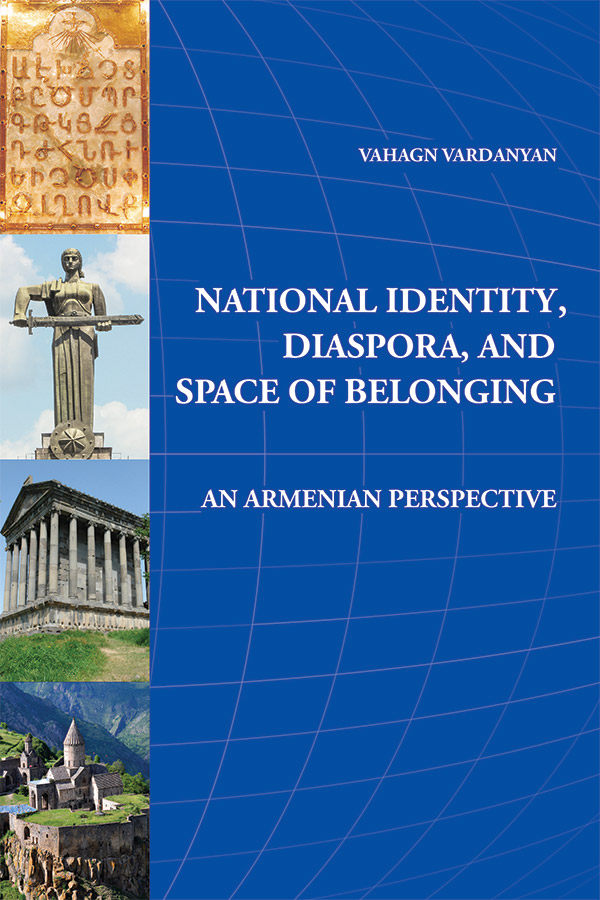
National Identity, Diaspora, and Space of Belonging: An Armenian Perspective
London : Gomidas Institute, 2021,
viii + 266 pp., maps, photos, tables,
ISBN 978-1-909382-69-5, pb.,
UK£25.00 / US$30.00
ISBN 978-1-909382-70-1, hb,
UK£40 / US$50.00
To order please contact books@gomidas.org
Diasporan communities live in an extraterritorial space. They are in both symbolic and physical ‘permanent return’ to their territorially bounded homeland. By being rooted in this sense of geographic belonging, their perception of national identity is set within a context of homeland-diaspora relations through the prism of space and place. In this book, Vahagn Vardanyan examines relations between one of the ‘classical’ diasporas – the Armenians and the Republic of Armenia – from the perspectives of diasporans. As he argues, these connections were transformed after Armenia acquired sovereignty in 1991. Over the three decades since then, it has become possible to study diaspora-homeland relations as they are viewed by diasporans who have seen Armenia before and after Armenian independence, and those, for whom independent Armenia has always been a reality and never a diasporic dream.
With fewer ethnic Armenians living in Armenia than in the diaspora, Armenia is increasingly viewed as responsible for becoming the cultural center for global Armenianness.
What is needed to reach an understanding between the homeland and its diaspora? How can, as diasporans see it, the homeland’s policy toward the diaspora facilitate their return and strengthen the diasporans’ sense of belonging to the homeland? These are among the many questions Vardanyan attempts to answer, while advocating an inclusionary policy toward the diaspora by a country, which is home to only a third of the global nation it claims to represent.
PREFACE (1)
PART I
Chapter 1 : THE ROOTS OF THE STUDY (13)
Understanding Diaspora: On-site Visits (23)
The Diasporan Representatives (29)
Chapter 2 : ARMENIA – A SMALL NATION-STATE WITH A GLOBAL DIASPORA (39)
Armenia Before and After 1991 (39)
Geographic Conditions (42)
Geopolitical Situation (44)
Economic Conditions (49)
Social and Cultural Conditions (50)
Chapter 3 : DIASPORA AND THE HOMELAND: TOGETHER AND SEPARATE (53)
Diaspora as a Phenomenon (54)
Nation Beyond the Nation-State: Homeland and Diaspora Return (57)
Diaspora and Homeland: Inclusion of the Transnational Formation (60)
Engaging the Diaspora: Transformation Over Time (66)
Engaging the Diaspora: The Role of Religious Institutions (71)
Engaging the Diaspora: A Homeland’s Rational Choice (73)
Understanding National Identity (76)
PART 2
Chapter 4: A CLASSICAL DIASPORA: THE ARMENIANS (85)
The Armenians: Diaspora and National Identity, Dimensions and Roots (85)
Distribution of the Armenian Diaspora (95)
The Armenians in Australia: An Insight into the Community (102)
The Australian Armenians: The Roots and the Routes (105)
Chapter 5 : DIASPORIC IDENTITY AND BELONGING (115)
Space of Belonging and Identity (115)
Historical Homeland: Perception of Reality or a Dream? (125)
Perception of National Identity (132)
Blood as a Marker of Armenian Identity (134)
Culture and Language in Armenian Identity (135)
Religion as a Component of Armenian Culture (139)
Living the National Identity (141)
Transformation of National Identity (141)
Chapter 6 : DIASPORA-HOMELAND: CONNECTION THROUGH SPACES (147)
Engagement Within the Community (147)
Types and Places of Engagement (150)
Connecting to Armenia: Barriers and Opportunities (157)
Knowledge of Armenian Language (162)
Physical Connection with Armenia (165)
Armenian Citizenship as a Connection (176)
Chapter 7 : HOMELAND-DIASPORA - INSTITUTIONAL DYNAMICS (179)
Diaspora Institutions: An Overview (179)
The Armenian Apostolic Church (185)
How is the Diaspora Changing? (194)
Does Community Size Matter? (201)
Chapter 8 : DIASPORA-ARMENIA RELATIONS - OVERCOMING THE CHALLENGE (205)
Challenges in Relations (205)
The Diaspora and the Homeland: Knowing Each Other (213)
Perspectives of Engaging the Diaspora in the Homeland (221)
Diaspora-Homeland Relations: The Problem of Contested Leadership (229)
CONCLUSION (237)
Institutions: The Role of the Armenian Apostolic Church (239)
Problems of Inclusion: Challenges Under Contested Leadership (240)
Permanent Return: A View from the Diaspora (242)
BIBLIOGRAPHY (249)
MAPS
Major Urban Armenian Communities of the World (viii)
Map of South-East Asia and Australia, including Armenia, Iran and India (19)
Republics of Armenia and Artsakh (Nagorno-Karabakh) (47)
Armenians in Australia (173)
ABOUT THE AUTHOR: A native of Armenia, Vahagn Vardanyan has been living in East/South-East Asia for nearly two decades. With a doctorate in political geography from NUS (Singapore), Dr. Vardanyan’s main areas of interest are national identity, nation/place branding, and homeland-diaspora relations. Vahagn Vardanyan has been active in the life of the Armenian community in the cities he has lived (Beijing, Singapore, Hong Kong) and participated in a variety of events of pan-Armenian importance in Armenia and the diaspora.
ABOUT THE AUTHOR: A native of Armenia, Vahagn Vardanyan has been living in East/South-East Asia for nearly two decades. With a doctorate in political geography from NUS (Singapore), Dr. Vardanyan’s main areas of interest are national identity, nation/place branding, and homeland-diaspora relations. Vahagn Vardanyan has been active in the life of the Armenian community in the cities he has lived (Beijing, Singapore, Hong Kong) and participated in a variety of events of pan-Armenian importance in Armenia and the diaspora.